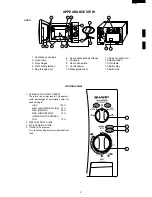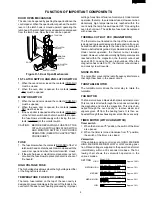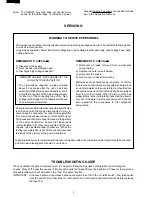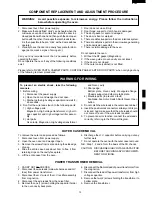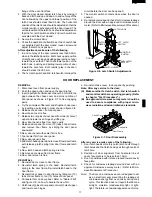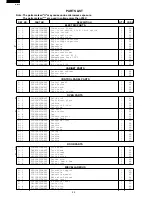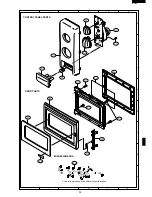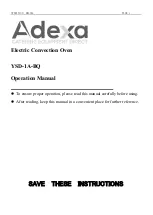
R-210A
17
flange of the oven front face.
2. With the door closed, adjust latch hook by moving it
back and forth and up and down. In and out play of the
door allowed by the upper and lower position of the
latch hook should be less than 0.5mm. The horizontal
position of the latch hook should be adjusted so that the
monitor switch is activated with the door closed. The
vertical position of the latch hook should be adjusted so
that the 1st. latch switch and the 2nd. latch switch are
activated with the door closed.
3. Secure the screws firmly.
4. Check the operation of all switches. If each switch has
not activated with the door closed, loosen screw and
adjust the latch hook position.
After adjustment, make sure of the following.
1. In and out play of the door remains less than 0.5mm
when in the latched position. First check upper position
of latch hook, pushing and pulling upper portion of door
toward the oven face. Then check lower portion of the
latch hook, pushing and pulling lower portion of door
toward the oven face. Both results (play in the door)
should be less than 0.5mm.
2. The 1st. latch switch and 2nd. latch switch interrupt the
circuit before the door can be opened.
3. The monitor switch contacts close when the door is
opened.
4. Re-install outer case and check for microwave leakage
around the door with an approved microwave survey
meter. (Refer to Microwave Measurement Procedure.)
LATCH HOOK
LATCH
HEADS
DOOR
MONITOR
SWITCH
1ST. LATCH
SWITCH
2ND. LATCH
SWITCH
SWITCH LEVER
Figure C-6. Latch Switch Adjustments
REMOVAL
1. Disconnect oven from power supply.
2. Push the open button and open the door slightly.
3. Insert a putty knife (thickness of about 0.5mm) into the
gap between the choke cover and corner portion of
door panel as shown in Figure C-7 to free engaging
parts.
4. Try the principles of the lever and lift up the choke cover
by inserting a putty knife in order shown in figure C-8.
5. Release choke cover from door panel.
6. Now choke cover is free.
7. Release two (2) pins of door panel from two (2) hole of
upper and lower oven hinges by lifting up.
8. Now, door panel is free from oven cavity.
9. Release door panel from ten (10) tabs of door frame
and remove door frame by sliding the door panel
downward.
10.Now, door panel with sealer film is free.
11.Tear sealer film from door panel.
12.Now, door panel is free.
13.Slide latch head upward and remove it from door frame
with releasing latch spring from door frame and latch
head.
14.Now, latch head and latch spring are free.
15.Remove door screen from door frame.
16.Now, door screen is free.
RE-INSTALL
1. Re-install door screen to door frame.
2. Re-install latch spring to the head. Re-install latch
spring to the door frame. Re-install latch head to the
door frame.
3. Re-install door panel to door frame by fitting ten (10)
tabs of door frame to ten (10) holes of door panel.
4. Put sealer film on door panel. Refer to "Sealer Film"
and figure C-9, on how to handle the new film.
5. Catch two (2) pins of door panel on two (2) hole of upper
and lower oven hinges.
DOOR REPLACEMENT
6. Re-install choke cover to door panel by pushing.
Note: After any service to the door;
(A) Make sure that 1st. latch switch, 2nd. latch switch
and monitor switch are operating properly. (Refer
to chapter "Test Procedures".).
(B) An approved microwave survey meter should be
used to assure compliance with proper micro-
wave radiation emission limitation standards.
10
5
4
12
8
7
9
11
3
2
1
Choke Cover
Door Frame
Putty Knife
6
Figure C-7. Door Disassembly
After any service, make sure of the following :
1. Door latch heads smoothly catch latch hook through
latch holes and that latch head goes through centre of
latch hole.
2. Deviation of door alignment from horizontal line of
cavity face plate is to be less than 1.0mm.
3. Door is positioned with its face pressed toward cavity
face plate.
4. Check for microwave leakage around door with an
approved microwave survey meter. (Refer to Micro-
wave Measurement Procedure.)
Note:
The door on a microwave oven is designed to act
as an electronic seal preventing the leakage of
microwave energy from oven cavity during cook
cycle. This function does not require that door be
air-tight, moisture (condensation)-tight or light-
tight. Therefore, occasional appearance of mois-
Summary of Contents for R-210A
Page 2: ...R 210A ...
Page 28: ...R 210A 26 97SHARP CORP 11K0 100E Printed in Japan ...

